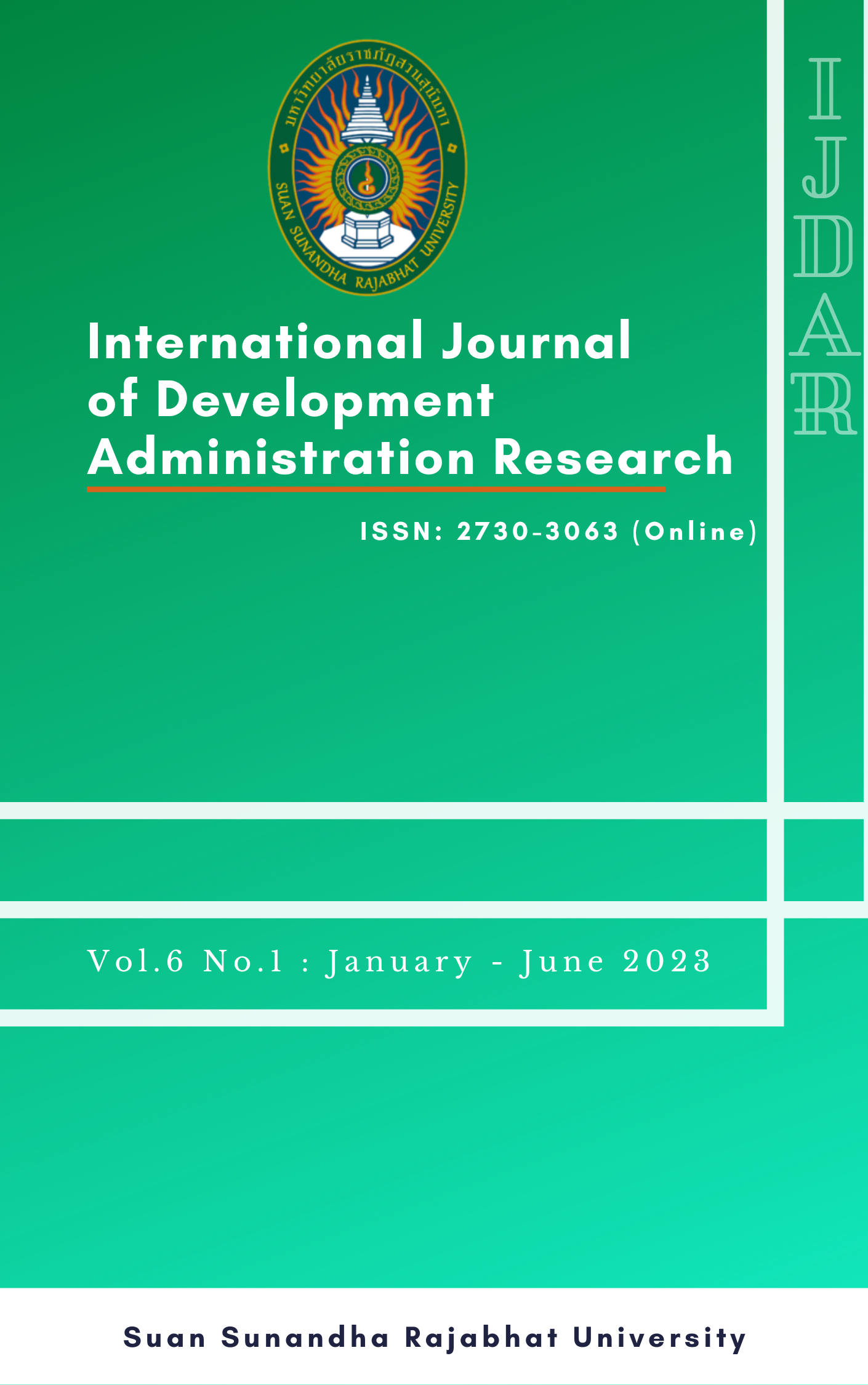Factors Affecting the Informatization Teaching Ability of University Professors: Using Theory of Technology Acceptance Model (TAM) A case study of one university at Shandong Province, China
Main Article Content
Abstract
This study aims to systematically analyze and identify the key factors that affect university professors' informatization teaching ability to improve talent training quality and promote sustainable development of higher education institutions. Specifically, analyze the impact of perceived usefulness and perceived ease of use of information technology on this ability, and propose strategies to enhance it. The quantitative research design using a questionnaire survey to collect data from the samples consisted of 269 professors at a university in Shandong province, China. The results indicate that perceived usefulness and perceived ease of use have a positive influence on university professors' informatization teaching ability. Based on these findings, this study proposes a strategy to improve university professors' informatization teaching ability.
Article Details
References
Agbo, I. S. (2015). Factors influencing the use of information and communication technology (ICT) in teaching and learning computer studies in Ohaukwu Local Government Area of Ebonyi State-Nigeria. Journal of Education and Practice, 6(7), 71.
An, Y. J., & Reigeluth, C. (2011). Creating technology-enhanced, learner-centered classrooms:K–12 Professors’ beliefs, perceptions, barriers, and support needs. Journal of Digital Learning in Teacher Education, 28(2), 54-62.
Buabeng-Andoh, C. (2012). Factors influencing Professors' adoption and integration of information and communication technology into teaching: A review of the literature. International Journal of Education and Development using Information and Communication Technology (IJEDICT), 8(1), 136-155.
Changchit, C., Lonkani, R., & Sampet, J. (2017). Mobile banking: Exploring determinants of its adoption. Journal of Financial Services Marketing, 22(3), 239-261.
ChanLin, L. J., et al. (2007). Factors influencing technology integration in teaching: A Taiwanese perspective. Innovations in Education and Teaching International, 44(1), 57-68.
Chasuwan, R., Aujirapongpan, S., & Ritkaew, S. (2022). Acceptance of Mobile Banking Technology of the Elderly in The Upper Southern Thailand. Journal of Business Administration The Association of Private Higher Education Institutions of Thailand, 11(1), 159-174.
Chen, L., Gillenson, M., & Sherrell, D. (2002). Enticing online consumers: An extended technology acceptance perspective. Information and Management, 39(8), 705-719.
Chiu, C. M., & Wang, E. T. G. (2008). Understanding Web-based learning continuance intention: The role of subjective task value. Information & Management, 45(3), 194-201.
Chuttur, M.Y. (2009). Overview of the Technology Acceptance Model: Origins, Developments and Future Directions. Sprouts: Working Papers on Information Systems, 9. Indiana University, USA.
Davis, F. D. (1989). Perceived usefulness, perceived ease of use, and user acceptance of information technology. MIS Quarterly, 13(3), 319–340.
Davis, F. D., Bagozzi, R. P., & Warshaw, P. R. (1992). Extrinsic and intrinsic motivation to use computers in the workplace. Journal of Applied Social Psychology, 22(14), 1111–1132..x
Eickelmann, B., & Vennemann, M. (2017). Professors' attitudes and beliefs regarding ICT in teaching and learning in European countries. Technology, Pedagogy and Education, 16(6), 727-748.
Elkaseh, A. M., Wong, K. W., & Fung, C. C. (2016). International Journal of Information and Education Technology, 6(3).
Hasan, B. (2007). Examining the Effects of Computer Self-Efficacy and System Complexity onTechnology Acceptance. Information Resources Management Journal (IRMJ), 20(3),
-87.
Hong, X., Zhang, M., & Liu, Q. (2021). Preschool Professors’ Technology Acceptance During the COVID-19: An Adapted Technology Acceptance Model. Frontiers in Psychology, 12, 691492.
Khong, H., et al. (2022). Examining Professors’ behavioural intention for online teaching after COVID-19 pandemic: A large-scale survey. Education and Information Technologies, 28, 5999-6026.
Li, Y., Fu, Z. T., & Li, H. (2010). Evaluating factors affecting the adoption of mobile commerce in agriculture: An empirical study. Journal of Agricultural and Applied Economics, 42(4), 1213-1218.
Lou, S. J., Wu, S C., Shih, R C., & Tseng, K H. (2015). Adoption of blogging by a Chinese language composition class in a vocational high school in Taiwan. Australasian Journal of Educational Technology, 31(2), 115-130.
Navavongsathian, A., Vongchavalitkul, B., & Limsarun, T. (2020). Causal factors affecting mobile banking services acceptance by customers in Thailand. The Journal of Asian Finance, Economics and Business, 7(11), 421-428.
Ozkan, S., & Koseler, R. (2009). Multi-dimensional students’ evaluation of e-learning systems in the higher education context: An empirical investigation. Computers & Education, 53(4), 1285–1296.
Park, J. H., & Choi, H. J. (2009). Factors influencing adult learners' decision to drop out or persist in online learning. Educational Technology & Society, 12(4), 207-217.
Park, S. Y. (2009). An analysis of the technology acceptance model in understanding university students' behavioral intention to use e-learning. Educational Technology & Society, 12(3), 150-162.
Shroff, R. H., Deneen, C. C., & Ng, E. M. W. (2011). Analysis of the technology acceptance model in examining students’ behavioral intention to use an e-portfolio system. Australasian Journal of Educational Technology, 27(4), 600-618.
Tondeur, J., et al. (2012). Preparing pre-service Professors to integrate technology in education: A synthesis of qualitative evidence. Computers & Education, 59(1), 132-143.
Venkatesh, V. & Davis, F. D. (2000). A theoretical extension of the Technology Acceptance Model: Four Longitudinal Field Studies. Management Science, 46(2), 186-204.
Venkatesh, V., & Bala, H. (2008). Technology Acceptance Model 3 and a Research Agenda on Interventions. Decision Sciences, 39(2), 273-315.
Venkatesh, V., Morris, M. G., Davis, G. B., & Davis, F. D. (2003). User acceptance of information technology: Toward a unified view. MIS Quarterly, 27(3), 425-478.
Vongchavalitkul, B., et al. (2022). The Implication Factors of Thai’s User Adoption toward Banking Technology in the Next Normal. The Journal of Development Administration Research, 12(4), 743-753.
Wang, Y. S., Wu, M. C., & Wang, H. Y. (2008). Investigating the determinants and age and gender differences in the acceptance of mobile learning. British Journal of Educational Technology, 40(1), 92-118.
Wright, V. H., & Wilson, E. K. (2011). Professors’ Use of Technology: Lessons Learned from the Teacher Education Program to the Classroom. SRATE Journal, 20(2), 49-60.


